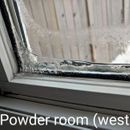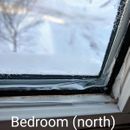Temperature, Relative Humidity, Dew Point, and Condensation on Windows
Hi,
A quick background to give you context. The 1867 sq. ft. (basement included) semi detach house was built in 2009 as part of a new large subdivision by a big developer in the west end of Ottawa. The house is a basic 2×6 wood frame, R-20 bat insulation, vinyl siding, natural gas furnace, no HRV and solid wood exterior doors. We keep the house temperature at 15°C (60°F) at night and during the day it’s at 20°C (68°F).
We have been seeing moisture build up on the windows since the first winter but the builder simply said it was moisture due to new construction. Before we moved in, we had bought a stand-alone dehumidifier that run almost year around in the living area in the basement and have it set at 45%.
We run the fans in the bathrooms 15-30 minutes after showering on a timer and the hood fan is running while we cook the majority of the time. When the weather is around 0°C (32°F), I will often open the door/windows to air out the house for 3-5 minutes but that only happens maybe once a month due to our cold Canadian winters.
This year I have decided to get rid of some of the plant I had in the house and only give them a tiny bit of water once every two weeks. This seems to have help reduce the amount of moisture that pools up at the base of the windows when the weather is between -1°C and -12°C (32°F – 10°F). The hygrometer in the kitchen island has been around 30% and the dehumidifier in the basement has been showing in the low 30% since Christmas.
On Sunday February 9, 2020 we had a very cold snap come though the Ottawa Canada area and at around 8:00am the temperature at -25°C (-13°F) and feeling like -31°C (-24°F). When we get cold weather around -20°C or colder, there will be ice forming on just about all of the windows.
After leaving in the house for ten years and reading a ridiculous amount on the subject, I believe on have narrowed it down to two issues; no HRV/ERV and cheap windows with low U-factor.
Anyone else have any thought?
Thank you,
Arnold
GBA Detail Library
A collection of one thousand construction details organized by climate and house part













Replies
That's common when it gets that cold, especially with builder grade windows.
At 68 F inside and 35% RH dew point is 40 F, temp the window inside surface needs to be above, so when its real cold you're gonna get frost. Increase inside temp and lower humidity to combat it if you're tired of wiping window sills.
Google "dew point" and "windows" and you'll get some reading.
I would be more concerned with a dehumidifier running nonstop to keep it at 45% well after year one.
Thank you T Carlson for the response. I should clarify that my dehimifier unit isn't dehumidifying all the time. My unit when powered on has the fan running non stop and the condenser only gets trigger on when the humidity drops below what I have it set at which is normally around 45%.
My builder grade windows are barre minimum the code require when it was built and I suspect they are at around an U-factor of 0.5 (R-2) but apparently they are Low-E.
I guess I will continue wiping away whenever the temperature gets below double digit celsius.
Thanks,
Arnold
I have rather expensive triple pane windows, and I still end up doing moisture of the windows at -20c. It probably buys be a little bit more leniency, but eventually you'll get condensation.
Hi,
I thought I would give an update for everyone else reading this thread in the future. In the spring I bought a new hygrometer on amazon which indicated to me that the other one I had was way off. A few day ago we bought a new dehumidifier (Frigidaire FFAD5033W1) after our ten year old one keep icing up and not really removing much moisture. In two days we been running it the relative humidity leave in the house went from 50-55% to the low 40%.
This morning the outdoor temperature was -15*C (5*F) and hardly any condensation on our windows. I suspect the old dehumidifier was not very effective at removing moisture, especially in the last year.
Thank you,
Arnold
You should find that a HRV in the Winter is a less expensive way to reduce humidity than a dehumidifier.
+1 !!!
A dehumidifier converts the moisture to sensible heat (temperature), but at a relatively poor coefficient of performance when the dew point of the indoor air is <10C (where it has to be to mitigate window condensation). The HRV/ERV solution is more efficient, and the slight heat loss from that ventilation rate is made up by a (hopefully) more efficient heating system.
Hi Arnold,
Here is a rabbit hole for you to go down: Understanding Dew Point. And to Dana’s point, should you start considering the efficiency of HRVs/Ervs as a future solution, this article by Martin Holladay lays out the differences and best applications for each: HRV or ERV?.
I agree an HRV would be better solution but given the cost to have one installed when we will be starting our new house build in 2021, it wasn't worth it. We're going to be putting that HRV money towards the new house.
Thank you,
Arnold
Dew point is defined as saturation vapor density or 100% relative humidity. Dew point is the transition temperature between evaporation and condensation. Condensation occurs on windows because the temperature of the glass is below the dew point temperature of the air. '
Dew point temperature is based entirely on the amount of moisture in the air and is unaffected by air temperature. Dew point temperature can be found using air temperature, relative humidity, and an appropriate chart. There is also an available formula of course, but I recommend a comparison chart...trust me on this one!
In order to stop condensation from forming on the surface of a window you have to:
(a) lower the dew point temperature of the air to a level below the temperature of the window surface
(b) warm up the window surface to a temperature above the dew point temperature of the air
(c) a combination of both
Relative humidity can be raised or lowered simply by adjusting room temperature. This change may make a person feel more comfortable, but changing temperature does not affect dew point. Lowering Rh by raising temperature MAY affect condensation on windows IF it also raises glass temperature above the dew point level. If the windows aren't sufficiently warmed by increasing room temperature then it will not affect window condensation.
Like changing room temperature, raising or lowering the moisture level of the air will also change the relative humidity in a space, but unlike changing temperature, changing moisture level will also raise or lower the dew point and this may affect the potential for window condensation. Preaching to the choir, but this is why dehumidifiers, ERV/HRV work and just raising the temperature "to dry the air" doesn't.
Quick example of changing temperature to control humidity:
Consider a home at 65°F with a relative humidity reading of 40%. In this scenario there are 6.25 grams of water in a cubic meter of air in the home which equates to a dew point temperature of 38°F. If the window glass is less than 38°F then there is a good chance there is moisture and maybe even ice buildup on the glass.
Clearly the Rh is too high, so we raise the air temp to 75°F and we have lowered the Rh to 29%, which most people would consider to be very dry no matter how you measure it. With the result that the windows still have condensation build up because despite the lower Rh, we have done nothing to lower the dew point. It's still at 38°.
Whole point being, be careful when talking about Rh and window condensation, it can be tricky and is often misunderstood.